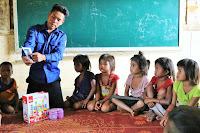Vientiane, Lao PDR, 10 October 2018 – The Ambassador of France to Lao PDR, Florence Jeanblanc-Risler, and Octavian Bivol, UNICEF Representative, signed today a new agreement to continue working together towards child protection system strengthening in Laos with a focus on the development and implementation of a regulatory framework on national and international adoptions.
“This agreement highlights the commitment of the Government of France to support the most vulnerable children in the country and adds to the remarkable work that the Government and development partners like UNICEF are doing to ensure every child is protected and grows in a safe environment,” said Ms. Jeanblanc-Risler.
With this new grant, the total amount mobilized over the last five years stands at EUR 74,000. Thanks to this contribution, the Ministry of Justice, with support from UNICEF, conducted an assessment on child protection and adoption in Lao PDR. In addition, the funding contributed to develop a new Adoption Decree, in alignment with international standards. The Decree was signed by the Prime Minister in June 2014. Following the approval of the decree, the Adoption Committee, consisting of members from justice, social welfare and health sectors were set up at national, provincial and district levels across the country. To raise awareness about the new Decree, training manuals were developed and a trainer of trainer workshop was conducted and subsequently trainings were held at subnational levels.
In this new collaboration phase, priority will be given to the development of an effective mechanism to enforce and monitor the implementation of the Adoption Decree which will contribute to strengthening of a child protection system in Lao PDR.
“Strengthening the capacity of government staff as well as para social workers at national, provincial, district and village levels for better case management is crucial, and the agreement we signed today will contribute to this. In addition, a district, provincial and national register for children without parental care will be established,” said Mr. Bivol.
Moreover, the grant will help raise awareness about the Adoption Decree on both domestic and intercountry adoption to create an enabling environment to pave the way for the ratification of The Hague Convention on Inter Country Adoption.
The Convention on the Rights of the Child (CRC) states that every child has the right to grow up in a family environment, to know and be cared for by her or his own family, whenever possible. When a child’s family is unavailable, unable or unwilling to care for her/him, then appropriate and stable family-based solutions should be sought to enable the child to grow up in a loving, caring and supportive environment. Intercountry adoption is among the range of stable care options. For individual children who cannot be cared for in a family setting in their country of origin, intercountry adoption may be the best permanent solution, when pursued in conformity with the standards and principles of the 1993 Hague Convention on Protection of Children and Co-operation in Respect of intercountry Adoptions – currently ratified by 95 countries.
About UNICEF
UNICEF works in some of the world’s toughest places, to reach the world’s most disadvantaged children. Across 190 countries and territories, we work for every child, everywhere, to build a better world for everyone. For more information about UNICEF and its work for children in Lao PDR, visit http://www.unicef.org/laos
About the Embassy of France
For more information, please contact:
The Department of Cooperation and Cultural Action, French Embassy in Lao PDR scac.vientiane-amba@diplomatie.gouv.fr








































